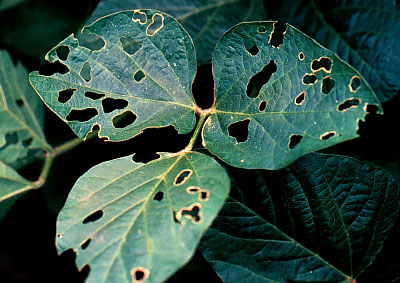
- cultivated since ca. 11th cent. B.C.E. in Manchuria, fermented in China since ca. 2nd century B.C.E.
Soybeans

- cultivated since ca. 11th cent. B.C.E. in Manchuria,
fermented in China since ca. 2nd century B.C.E.
- rich in protein (4,4 % - milk: 2.9 %): can be steamed, roasted, processed to become meat-like or like dairy products (milk, cheese); the sprouts can be eaten
- some sorts used to feed chicken
- each plant produces 60-80 pods with three beans each; the plant also draws
nitrogen from the air and transfers it to the ground
- first introduced to the US in 1767 by Samuel Bowen
and grown in Savannah, Georgia. Henry Ford experimented in the 1930s and 40s
with soybeans to produce margarine and salad oil. The US produces 2/3 of the
world production predominantly used to feed chicken.
- Argentina and Brazil produce 28% of the world production of soy beans, which
is responsible for large sacale destruction of the rainforest

 Attacked by beetles
Attacked by beetles
Soybean irrigation
 soybean rust
soybean rust
How to make Doufu:
- immerge the beans in water overnight, drain the water
- mash the beans while adding boiling water ("bean-porridge")
- portions of mixture are ladled into boiling water and cook for 10 minutes
- filter the mixture; soy milk is thus separated from pulp (can be used to feed
pigs)
- coagulate the milk with Calcium Sulfate or Magnesium Chloride: the milk separates
into curds (floating on top) and whey (can be used to feed pigs);
- scoop out the curds and ladle into container lined with cheese cloth; drain
again and cover with a weighted lid overnight
- remove the doufu piece from the container and place
in a container with cold water